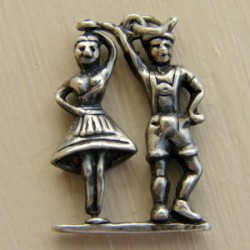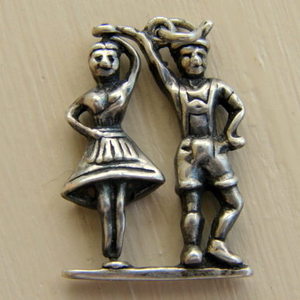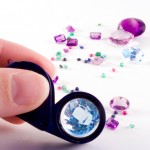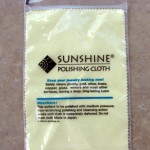Vintage Jewelry – Is It Real Gold Or Silver?
 When buying vintage jewelry, the best and most surefire way to ensure the piece is truly the metal quality you are expecting, is of course to view a hallmark of the metal purity, such as 14K or Sterling Silver somewhere on the item. If there's no stamped hallmark, the next best guarantee of metal purity is to have the piece tested by a professional jeweler. When buying an expensive piece of jewelry one of these methods should be utilized for absolute verification of authenticity.
When buying vintage jewelry, the best and most surefire way to ensure the piece is truly the metal quality you are expecting, is of course to view a hallmark of the metal purity, such as 14K or Sterling Silver somewhere on the item. If there's no stamped hallmark, the next best guarantee of metal purity is to have the piece tested by a professional jeweler. When buying an expensive piece of jewelry one of these methods should be utilized for absolute verification of authenticity.
Some collectors recommend only buying stamped jewelry. They consider unmarked pieces to be plated or filled by virtue of the fact they are not marked. While this may be true of newer gold and silver jewelry, there are many antique and vintage pieces that were not hallmarked and truly are made from precious metal. Charm collectors know this in particular, as there are plenty of examples of unmarked sterling silver vintage charms that are in high demand and draw premium prices.
For those of us who buy collectible fine vintage jewelry that's not intended to be heirloom or investment quality, there are other methods that are often used to establish the value of an item. Gold, silver, and platinum metals are not magnetic, and this is a simple test that can help to verify the metal quality, although the magnet test should not be relied upon by itself. If the jewelry item has magnetic qualities it's likely made from nickel or steel. Also, an indication of metal purity is its hardness or malleability. Precious metals are soft and if the item is large and thin it should be pliable.
Another way of determining metal purity is acid testing. Acid tests for gold, silver, or platinum are available for sale on the internet and in jewelry supply stores. These are sold in kits that contain several bottles of acid and a stone used to scrape a bit of the surface from an item of jewelry. Acid testing is done correctly by scraping an inconspicuous area of the jewelry piece on the stone and then placing a drop of the acid on the metal residue left there. I prefer to scrape the item once on the stone and then wash it off and repeat a second time. The second scrape will contain a good sample of the underlying metal. The drop will turn a color which can be compared to a chart indicating the purity. Alternatively one can file the jewelry surface with a steel file and drop the acid directly on the piece, which is actually a good test in itself as it will be easy to file fine gold or silver, whereas the file will slide off an item made from steel.
Gold acid test kits come with a solution for each level of gold quality, 10K, 14K, 18K, etc. and will give a reading when the applicable solution is applied. I usually start with 14K and if necessary work my way up or down depending on the results. Silver test kits come with just one type of solution and it turns a different shade or red, brown, or green to denote the silver purity.
Acid testing is not a fool-proof method, as there can be factors that give a false reading, and typically the results are subjective regarding the metal purity level. But if the test is done properly there is a reasonable chance that the outcome is reliable. If you're testing jewelry, or buying from someone who is testing it, here are a few things to double check of the process. First make sure the testing solution is fresh. These solutions are made from nitric acid and can go stale after several months. Second, the jewelry item must be scratched hard enough on the stone that any plating is removed from the surface and the base metal is exposed. These steps help to ensure a relatively accurate test.
As a collector gains experience handling precious metals, it becomes easier to gauge quality by touching and viewing them. Silver in particular acquires a soft sheen, or patina, after many years of use. A trained eye and good judgment becomes key when buying or selling fine jewelry. Nothing can take the place of dealing with reputable sources and developing your own expertise. The fun of collecting is in the hunt, and researching and testing your purchases is part of the experience. Armed with a little bit of knowledge you can make wise choices and join the fun of vintage jewelry collecting.

More from my site
Category: Facts & Useful Info









